The Secrets of Archon
December 16th, 2005 by MedarchA detailed look into one of the best games of all time
v1.0 – by Medarch

I would say ‘greatest,’ but that usually means influential, which Archon hasn’t been particularly. But that only serves to solidify its uniqueness. Billed as a combination action/strategy game upon its release in 1983, Archon ends up being far more action-oriented, but the diversity of characters from the fantasy realm and their combat attributes the game employs should be enough to dazzle any self-respecting game geek.
Answering the call of my own inner geek, I have exposed Archon‘s mechanisms and hidden numbers through days of experimentation with the game’s original and best version, that for the Atari 800. The description, analysis, and numbers below pertain only (as far as I know) to the Atari 8-bit computer version of Archon.
Recently I’ve been thinking about building a new Archon-type game for Windows. The first step, I figured, was to find a detailed FAQ on the original, but since apparently none exist, I had to make one myself. And so this report was born…
Archon is a war between the Light and the Dark: two armies of creatures and persons of myth and legend, called by the game ‘icons.’ Each side begins with a force of 18 icons, with 8 different types per side. The Light and the Dark do not share any types, yet the teams are very evenly matched. The armies alternate turns, maneuvering for position on a chessboard-like Strategy Screen. On a single turn either one spell may be cast, or one icon moved. Turns may not be passed. Whenever an icon is moved to a square already occupied by an opposing piece, a battle ensues on the Combat Screen, where each different type of piece has its own hit points, attack damage, and so on, detailed below. The winning icon keeps the square, while the loser is eliminated from the game (both icons may be destroyed in the battle, in which case both are eliminated).
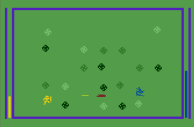 Each side aims to occupy the five ‘Power Points’ on the board or to completely eliminate the opposition. Victory can also be achieved by casting the Imprison spell on the opponent’s last remaining icon. The game can end in stalemate as well in either of two ways: the last two icons destroy each other in battle, or there is no progress for a certain number of turns. (‘Progress’ here means battles or Spells cast, and the number of turns is at least one full cycle of color-change (12 turns per side) but depends on the number of pieces left and has been difficult to determine in some cases.) Games usually last between 50 and 100 turns per side if the players are well-matched.
Each side aims to occupy the five ‘Power Points’ on the board or to completely eliminate the opposition. Victory can also be achieved by casting the Imprison spell on the opponent’s last remaining icon. The game can end in stalemate as well in either of two ways: the last two icons destroy each other in battle, or there is no progress for a certain number of turns. (‘Progress’ here means battles or Spells cast, and the number of turns is at least one full cycle of color-change (12 turns per side) but depends on the number of pieces left and has been difficult to determine in some cases.) Games usually last between 50 and 100 turns per side if the players are well-matched.
The strategic side of Archon takes place on a 9×9 grid of squares of three types: perma-light, perma-dark, and the ones that cycle through those two colors plus four more intermediate shades of green. The cycle repeats, progressing from lightest to darkest and back again, with one turn for each player at each color. I call these six colors ‘A’ through ‘F’, with ‘A’ being the lightest. The color of the square affects the hit points (more about that later) of both fighting creatures when a battle takes place there, with the Light Side benefiting from lighter squares and the Dark Side from darker.
When the Light Side moves first to open a game, the changing squares will begin at ‘D’ and proceed darker, changing after each turn of the Dark Side. When Dark moves first, the changing squares begin at ‘C’ and initially grow lighter. Moving first, therefore, has the disadvantage of quickly exposing your icons that begin on the changing squares.
At the edges and center of the game board are the five blinking red ‘Power Points:’ one on a perma-light square where the Wizard starts, one on a perma-dark that the Sorceress controls, and three on squares that change color. Often, the entire game revolves around the battle for the three in the middle. Each of the five Power Points protects its square, as well as any icon on it, from being the target of a Spell. They also have healing properties (see the Hit Points and Damage section). Capturing all five wins the game.
Spells
The leader of each side is a mage (Wizard for Light, Sorceress for Dark) with a selection of seven spells. The Wizard and Sorceress have the same list of spells and may cast each once per game. If a mage is killed in combat, his/her remaining spells are gone. No spell may target a ‘Power Point’ square or an icon on one. Thankfully, if the spell you choose has no legal targets, the game will realize it and tell you to choose another spell.
The Archon manual mentions that each time a spell is cast, the mage becomes weaker, but this is not quite true. Casting spells, as it turns out, will reduce the hit point bonus gained for the mage’s home square: one HP per spell cast. Any creature standing on it suffers the hit point penalty, even after the mage is killed. And a mage, even after casting spells, does not suffer the penalty when away from that square.
Teleport:
Early in the game, the computer A.I. loves to use this spell to catch a Basilisk on its weak starting square with a Unicorn (or vice-versa). Same with Banshee/Valkyrie, and sometimes a Golem (or Troll) will be sent across the board to take out a Goblin (or Knight). Less often, the computer will use the same technique with its heavy-hitters. The only other use the computer has for this spell is to put something (usually a Golem/Troll) within striking distance of the other team’s mage. All are worthy uses of this great spell, but a human player can be more creative.
Heal:
The computer usually saves this spell for the Djinn, Phoenix, or Dragon, but the Wizard and Sorceress sometimes heal themselves late in the game as well. See the Hit Points and Damage section for more information.
Revive:
The computer will only use this spell to bring back one of its strongest two creatures, usually whichever is the first to die.
Exchange:
The best use of Exchange is probably to move one of your Basilisks, Trolls, or Golems into the fray quickly. Trapping an enemy ground mover is possible, but the time cost to set it up usually negates any benefit. This is the only spell the computer never uses.
Shift Time:
The computer prefers to use Shift Time when there’s an Imprison spell in effect (see below) but will also just employ it to give itself more time to try for all the Power Points.
Summon Elemental:
The computer uses this spell to attack the opposing heavy-hitters caught on weak squares or when just about any enemy icon wanders suspiciously close to its mage. Moving your mage off its protective Power Point will usually trigger a Summon from the computer opponent also. Win or lose, the elemental is gone forever after its battle. The combat attributes of the elementals are given below in the Creatures section.
Imprison:
The computer will only cast this spell in when the color cycle is ‘C’ or ‘D’ and heading toward its favored color. It also loves to extend (or reduce) a prison sentence with the Shift Time spell, but it’s smart to save Imprison for the endgame, when you can freeze your opponent’s last piece and win immediately.
Archon displays creatures’ health (what I call hit points) in vertical bars at the sides of the combat screen. No numeric values are given in the game or the manual, but experimentation reveals that both hit points and damage quantize nicely into fairly big units. The catch is that hit points are offset by one-half unit from damage, such that damage is always delivered in integral amounts, but hit points are always something-and-a-half. Sure, we could get rid of the halves by doubling all values, but I prefer working with the smaller figures. (Now, it is very likely that in Archon‘s program, hit points are actually integers, 0.5 lower than the values I give and that creatures must be reduced to below 0 to be killed. But since the zero-hit-point level is drawn as some positive amount on the screen, I’m going to call that one half.)
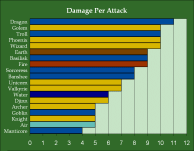 Several factors determine the hit points a creature will have in battle: the creature’s base HP, any injuries it may have sustained, the bonus for square color, and, if on the mage’s home square, a penalty (counting against the square color bonus) of 1 HP per spell the mage has cast.
Several factors determine the hit points a creature will have in battle: the creature’s base HP, any injuries it may have sustained, the bonus for square color, and, if on the mage’s home square, a penalty (counting against the square color bonus) of 1 HP per spell the mage has cast.
The HP bonus for square color (from ‘A’ to ‘F’) is as follows for Light Side icons: 7, 6, 4, 3, 1, and 0. It’s the opposite for the Dark Side, which gets 7 additional hit points for ‘F,’ 6 for ‘E,’ etc. For an icon to sustain an injury that persists after the battle, it must take damage in excess of its bonus for square color. For example, if a Dragon attacks a Knight (both uninjured) on ‘E,’ the Dragon will have 22.5 HP after its bonus of 6, and the Knight will have 5.5 after its bonus of 1. Let’s say the Knight manages to get in 2 hits before dying. That’s a total of 10 damage’¦minus the square bonus of 6’¦equals 4 points of injury done to the Dragon, a reduction that will show up in its next fight unless it’s healed.
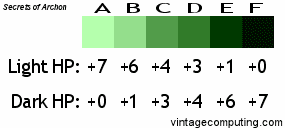
Icons can be healed in two ways. First is the Heal spell, which heals all damage to that one icon immediately. The other way is via a Power Point. At the end of any of your turns, any of your icons on a Power Point regain 1 HP if they’re not already healthy.
Creature Statistics and Information
Below is a list of all the creatures in the game, including a description and information about each.
Pawns: the Knight and the Goblin

The Knight and Goblin are identical in all ways except the shapes of their bodies and weapons’”differences small enough to defy analysis.
|
Knight Move: Ground 3 Base HP: 4.5 Max HP: 11.5 Speed: Normal Attack Power: 5 Shot Speed: N/A Attack Rate: Ultra Fast (3/2 atks/sec) Sword Width, Horizontal Attacks: 2 Sword Width, Vertical Attacks: 4 |
Goblin Move: Ground 3 Base HP: 4.5 Max HP: 11.5 Speed: Normal Attack Power: 5 Shot Speed: N/A Attack Rate: Ultra Fast (3/2 atks/sec) Club Width, H: 2, V: 4 |
Scouts: the Archer and the Manticore

The Archer is basically a Knight who shoots with a bow. He can hold his own on favorable squares (‘A’ and ‘B’); however, the Archer is quite vulnerable on the medium squares (‘C’ and ‘D’), where one shot from a Basilisk, Troll, or Dragon will take him out, as will two bashes from a Goblin’s club.
The Dark Side’s Manticore owns the weakest attack in the game, but he makes up for it with a decent hit point total and his widely-spaced tail spikes, which are hard to dodge at close range. He will have trouble against the Wizard or Unicorn and should avoid Knights on squares ‘A’, ‘B’, or ‘C’, where he’ll need 3 hits to kill them. The Manticore is excellent for trying to pull off an upset against a Djinn or Golem; those matchups can be very entertaining.
|
Archer Move: Ground 3 Base HP: 4.5 Max HP: 11.5 Speed: Normal Attack Power: 5 Shot Speed: Medium (70%) Attack Rate: Medium (3/4 atks/sec) Projectile Width, H: 1, V: 2 |
Manticore Move: Ground 3 Base HP: 7.5 Max HP: 14.5 Speed: Normal Attack Power: 4 Shot Speed: Slow (50%) Attack Rate: Medium (3/4 atks/sec) Projectile Width, H: 5, V: 10 |
Fliers: the Valkyrie and the Banshee

The Valkyrie improves on the Archer, having moderate hit point and damage levels. Her weakness is that her spears are both slow and narrow, so the Valkyrie must get in close for a successful attack (preferably on the diagonal). No other slow-shooter in the game has projectiles merely one pixel wide. The Valkyrie is excellent on medium squares, except against the Dragon on ‘D’, where one blast of fire will roast her.
It’s always fun and challenging to use the Banshee because of its unique attack form: a scream-cloud that quickly drains the life of an opponent caught within its radius. Life is drained 1 HP at a time, for a total of 8 if the cloud hits for the full duration. The Banshee can move while screaming, which is a mixed blessing’”it’s impossible to escape from the scream, but the Banshee is left extremely vulnerable after (and during) the attack. In light of this, the Banshee is best used for polishing off badly injured opponents, and in this task it has no equal, but it’s helpless against a foe with a tall health bar. Perhaps more than any other creature, the Banshee needs to stick to its favorable squares.
|
Valkyrie Move: Fly 3 Base HP: 7.5 Max HP: 14.5 Speed: Normal Attack Power: 7 Shot Speed: Slow (50%) Attack Rate: Medium (3/4 atks/sec) Projectile Width, H: 1, V: 4 |
Banshee Move: Fly 3 Base HP: 7.5 Max HP: 14.5 Speed: Normal Attack Power: 1-8 Attack Rate: Slow (3/5 atks/sec) Scream Cloud Size: 64×32 |
Brutes: the Golem and the Troll

Golems have 1 more hit point than Trolls, but otherwise they’re equivalent in ability. That extra HP does come in handy for the Golem sometimes’”for example, in a head-to-head matchup on ‘E,’ where the Troll should be favored, both need only 2 hits for victory.
|
Golem Move: Ground 3 Base HP: 14.5 Max HP: 21.5 Speed: Slow (75%) Attack Power: 10 Shot Speed: Slow (50%) Attack Rate: Slow (3/5 atks/sec) Projectile Width, H: 8, V: 12 |
Troll Move: Ground 3 Base HP: 13.5 Max HP: 20.5 Speed: Slow (75%) Attack Power: 10 Shot Speed: Slow (50%) Attack Rate: Slow (3/5 atks/sec) Projectile Width, H: 8, V: 12 |
Assassins: the Unicorn and the Basilisk

The Unicorn is the real workhorse of the Light Side; its unique movement range of Ground 4 makes it the most annoying enemy of Dark as it gallops around blockades and picks off anything left too long on a color-changing square. It’s also excellent against the Dragon on middle-color squares and is Light’s best hope against the Sorceress on her home turf, where the Unicorn can absorb a hit and still fight on’¦ and may only need 2 hits for the kill if the Sorceress has already cast three spells. In this case, the Unicorn’s supremely fast laser beams actually make it favored, which is one of Light’s most important advantages. The Unicorn does well on ‘D’ but should beware of darker squares, where it can be taken out by 1 shot from a Dragon, Troll, or Basilisk (on ‘F’).
Taking into account damage, attack rate, shot speed, and projectile width, the Basilisk is unquestionably the most potent attacker in Archon. Long-range foes have trouble dodging the Basilisk’s super-fast petrifying gaze, and its 10-pixel-wide vertical shots make it nearly invincible against anything that likes to get in close for an attack. The Basilisk often wins games for the Dark Side, either by dethroning the Wizard or by destroying half a dozen Light pieces in a row. Its one glaring weakness is hit points, so the Basilisk must be careful, especially avoiding Unicorns on lighter squares if possible.
|
Unicorn Move: Ground 4 Base HP: 8.5 Max HP: 15.5 Speed: Normal Attack Power: 7 Shot Speed: Very Fast (100%) Attack Rate: Very Fast (1 atk/sec) Projectile Width, H: 1, V: 2 |
Basilisk Move: Ground 3 Base HP: 5.5 Max HP: 12.5 Speed: Normal Attack Power: 9 Shot Speed: Very Fast (100%) Attack Rate: Very Fast (1 atk/sec) Projectile Width, H: 3, V: 10 |
Hunters: the Phoenix and the Shapeshifter

The Phoenix has a short-range attack similar to the Banshee’s, but it defends the Phoneix even as it harms enemies. While its flame is on, the Phoenix is impervious to attack’”but immobile. This is a terrible weakness, since it can almost always be hit just as the flame expires, making this bird worthless against players who know what to do. (This flaw was corrected in Archon II’s Firebird, who can cut short its flame attack.) Creatures with slower attack rates have more trouble taking advantage of this trick, so the best job for the Phoenix is to slay Dark’s 2-seconds-per-shot Dragon. A computer opponent will not use the trick at all, so in that case the Phoenix can have great success against Goblins, Banshees, and Trolls as well. A Phoenix-Shapeshifter battle is often a long, boring affair (each flame protecting against the other) in which the one with the most hit points coming in almost always wins. This is never good for the Phoenix, though, who is sure to suffer severe injury if victorious.
The Shapeshifter may be the Dark Side’s greatest advantage. As its name suggests, it takes on the form and abilities of its opponent in combat. The opponent’s base HP are also used, but the Shapeshifter of course gets the Dark Side’s HP bonuses for square color. This means that on ‘E,’ and especially ‘F,’ it will have a big advantage. Unless you’re confident, though, you shouldn’t start attacking early in the game on squares ‘C’ and ‘D’ because the Shapeshifter is evenly matched against just about any opponent before they’ve sustained injuries. The Shapeshifter’s best feature is that, unlike any other piece, it never suffers permanent damage’”it’s always completely healed after every battle. Plus, the computer A.I. has a bad bug where it attacks the Shapeshifter, even on dark squares, as if it did not heal after being damaged! The Shapeshifter’s hit points work a little differently against Elementals, when it gets a base HP of 9.5’”not all that much’”plus the usual color-bonus, regardless of which Elemental it faces. This is the ‘˜Shifter’s biggest weakness, as it’s an even fight with a Fire or Earth Elemental, even on the darkest of squares’”something a smart Light Side player will use to his advantage.
|
Phoenix Move: Fly 5 Base HP: 11.5 Max HP: 18.5 Speed: Normal Attack Power: 2-10 Shot Speed: N/A Attack Rate: Slow (3/5 atks/sec) Flame Cloud Max. Size: 64×32 |
Shapeshifter Move: Fly 5 |
Champions: the Djinn and the Dragon

The Djinn has as many hit points as a Golem but significantly less attack power, delivering a relatively low 6 damage per shot. His shots are large and swift, though, giving Goblins and Banshees little chance for survival and Trolls not much more. He should avoid the Dragon and Basilisks on medium-color squares, but, if healthy, the Djinn is the only Light Side icon to have an advantage in shots-to-kill over the Shapeshifter on ‘C.’ The Djinn is fairly vulnerable to Elementals, especially Fire, on the three darker square colors, so he needs to be moved to safety as early as possible. When Light needs to take out the Sorceress on her home square to win the game, the Djinn is an excellent choice for the attack.
The Dragon is the strongest and most intimidating creature in the game. No opponent, on any color square, can withstand two blasts of his fire, and many are roasted with just one. The Dragon’s health bar, too, towers over all others with an incredible maximum of 23.5 hit points; some foes will need five hits to bring him down. He pays for these gaudy numbers, however, with a miserable attack rate of one shot every two seconds, the worst in the game. Consequently, the Dragon can really struggle against the Phoenix and against the swift-shooting Unicorn on medium squares. In most cases, though, the Dragon will have the upper hand, notably against any Elemental, no matter what color square. Light should save his Elemental attack for the Shapeshifter instead. Dark should make sure to Heal the Dragon if his health gets low.
|
Djinn Move: Fly 4 Base HP: 14.5 Max HP: 21.5 Speed: Normal Attack Power: 6 Shot Speed: Medium Fast (80%) Attack Rate: Med. Slow (2/3 atks/sec) Projectile Width, H: 5-7, V: 8 |
Dragon Move: Fly 4 Base HP: 16.5 Max HP: 23.5 Speed: Normal Attack Power: 11 Shot Speed: Medium (70%) Attack Rate: Very Slow (1/2 atks/sec) Projectile Width, H: 4, V: 6 |
Mages: the Wizard and the Sorceress

If you’re playing the Light Side, your favorite piece will be the Wizard. He’s an awesome, intimidating fighter who shoots fireballs that are large, powerful, and swift. Dark shouldn’t bother attacking him with anything less than its best creatures. The Wizard is very rarely the underdog; if he does need to go wandering away from his home square, he should avoid the Dragon on ‘D,’ Basilisk on ‘E,’ and Shapeshifter or Troll on ‘F.’
Dark’s spellcaster is the Sorceress, whose lightning bolts are faster than her rival’s fireballs, but are smaller and less powerful. She’s not quite as good as the Wizard in combat, but is still more than a match for any Light piece on a medium square. Dark players may enjoy using the Sorceress as an attacker and handing off Power Point guard duty to a Dragon or Troll.
|
Wizard Move: Teleport 3 Base HP: 9.5 Max HP: 16.5 Speed: Normal Attack Power: 10 Shot Speed: Medium Fast (80%) Attack Rate: Medium (3/4 atks/sec) Projectile Width, H: 6, V: 8-12 |
Sorceress Move: Teleport 3 Base HP: 9.5 Max HP: 16.5 Speed: Normal Attack Power: 8 Shot Speed: Fast (90%) Attack Rate: Medium (3/4 atks/sec) Projectile Width, H: 2, V: 4 |
Elementals: Air, Water, Earth, and Fire

Overall, the weakest of the bunch is probably the Air Elemental, whose projectiles look like the Djinn’s but are a bit slower and weaker. It is similar to the Archer, but better due to its larger bullets and unique attack rate of 6 shots every 7 seconds. The Air Elemental is also the only icon with physical gaps in its body, allowing the horizontal attacks of some creatures (Djinn, Unicorn, Valkyrie, Archer, Shapeshifter, Basilisk, and Manticore) to pass right through, if it’s lucky. It’s probably best used against a Unicorn or Shapeshifter.
Marginally better than Air is the Water Elemental. It has more HP and does more damage than Air, but cannot shoot as often. Pratical results with Water will be similar to Air, but Water can take out a Basilisk on ‘A’ with one shot and will have at least an even fight against a Shapeshifter on any square.
The Earth Elemental is a poor man’s Troll, having the same lumbering pace but fewer HP and dealing not quite as much damage. At 9 per shot, though, Earth still packs a punch. You might use it to take out some weaker foes with 1 shot, and it probably is the best Elemental against the Dragon.
Fire is, without a doubt, the best Elemental the spell can buy. Similar to a Basilisk, Fire can do damage in a hurry, mimicking the Basilisk’s attack power and attack rate. Its bullets aren’t quite as fast, but they’re still swift enough to get the job done. Fire is great against just about anybody, but especially against a Djinn, Unicorn, or Basilisk. It has very few hit points, though, and can be taken out by 1 shot of a Dragon, Golem, or Troll.
|
Air HP: 11.5 Speed: Normal Attack Power: 5 Shot Speed: Medium (70%) Shot Rate: Medium Fast (6/7 atks/sec) Projectile Width, H: 5-7, V: 8 |
Water HP: 13.5 Speed: Normal Attack Power: 6 Shot Speed: Slow (50%) Attack Rate: Slow (3/5 atks/sec) Projectile Width, H: 3-6, V: 4-10 |
|
Earth HP: 16.5 Speed: Slow (75%) Attack Power: 9 Shot Speed: Slow (50%) Shot Rate: Slow (3/5 atks/sec) Projectile Width, H: 8, V: 12 |
Fire HP: 9.5 Speed: Normal Attack Power: 9 Shot Speed: Medium Fast (80%) Attack Rate: Very Fast (1 atk/sec) Projectile Width, H: 3-6, V: 4-10 |
Get the Game
If you’d like to play Archon and you don’t have access to the original Atari hardware or software, I recommend using an emulator like Atari800Win PLus with an Archon disk image. For the best play experience, you’ll need a good joystick as well. Have fun!
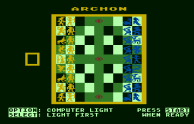
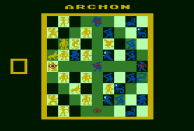
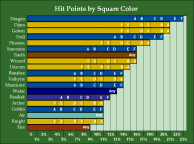


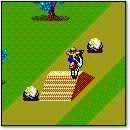
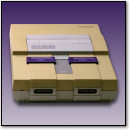
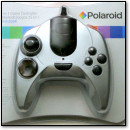
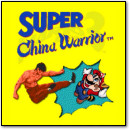
December 16th, 2005 at 10:44 pm
If anyone out there can determine whether these numbers I found for the Atari version are the same in other versions (Commodore, Amiga, etc.), I’d love to hear about it! Thanks,
Medarch
January 3rd, 2006 at 8:28 am
I just wanted to say thanks for your efforts here. I grew up on this game, and the second one. Never really got into the third.
January 3rd, 2006 at 4:02 pm
Cool. I just got Archon II on cartridge for the 800, so of course I need to do an article for that one now!
March 7th, 2006 at 1:02 pm
Was there a Macintosh version — I can’t seem to find one ….
If there is, PLEASE feel free to email me.
Later!
March 17th, 2006 at 4:59 pm
Very cool write up here, i am surprised this hasn’t reached the mobile games market yet.
March 25th, 2006 at 6:05 am
Wow! This is just the information I was looking for. Great game. Now… if only I could find someone to play it with…
April 7th, 2006 at 12:42 pm
Wow. I totally needed this information. I am looking at doing a write-up for the DOS version of this game (which I understand is virtually identical having been made by the same group). One thing I was wondering if the manual for this game (any version) can be found anywhere?
May 21st, 2006 at 11:53 pm
A very enjoyable and informative guide to one of my favorite old games. I even have nicknames for the Wizard (Giz), the Dragon (Dragonbait) and the Unicorn (Serta Sheep). Silly, but hey, it’s just a game…
My favorite good guy piece has always been the Unicorn. Without those workhorses (nice pun, by the way!), it’s hard to see the light at the end of the tunnel!
I am fairly certain that your info applies to the Commodore 64 version, too.
Guesst, I have an original copy of Archon- the case, manuals, reference guide, everything. I just need to find it…
June 10th, 2006 at 1:52 am
I have a disk copy of Archon from my old Atari 800 and would love to play it on my PC. It was a tremendous favorite of mine which I did not think was surpased by PC/MAC games until I played the game WarCraft.
At one time there was an active C 64 group getting their programs onto the PC via emulation etc. I am not sure what the case is regarding the Atari 800.
I am not a programmer, but would be interested in participating in the project to get Archon onto Windows in any way I am able.
This is a great site and has brought back a lot of great gaming memories!
June 21st, 2006 at 8:29 am
Yes, very well documented guide indeed.
If I remember well though, you could choose which elemental you wanted to summon. If the elemental you just summoned wasn’t the one you were interested in, just cast the spell on a “power point” which would cancel the spell. Then cast it again to see another elemental be proposed. Then just rinse and repeat until the one you’re interested in is summoned.
July 2nd, 2006 at 8:14 pm
Excellent article… Really excellent!
One of my favourite games ever. Maybe because I was able to win (the Archon II was too difficult ;)).
September 9th, 2006 at 10:03 pm
Thanks for this info, just been rediscovering old games I used to play in my youth, as well as others (like this) that I never got around to playing first time round.
Good luck with your Windows version, although I use a Mac 😉
November 21st, 2006 at 12:12 am
I really loved this game. Is there any equivalent for a modern PC?
November 29th, 2006 at 12:38 pm
I loved this game, still love it in fact, and the info here is wonderful. The trick of choosing your elemental by casting onto a power point doesn’t work on the C64 version, however. It just makes your retarget the spell, not recast it entirely. I play Archon now on an emulator, and it works fine, though it looks weird to see the Commodore prompt on my laptop 🙂
December 30th, 2006 at 6:26 am
Thanks for this great info! In my opinion, Archon is still the best head-to-head 2D-shooter available. I know at least a dozen persons who play the various emulated versions on their PCs. I wonder why there is no dedicated fan page and/or league for it, yet.
Apart from the above Atari version you can easily find the other versions on the web:
PC: http://www.the-underdogs.info/game.php?id=1784
C64: http://almighty.c64.org/games/Archon.zip
Amiga: http://www.back2roots.org/
Does anybody know of a hack to play it via internet?
February 8th, 2007 at 12:06 am
Archon was & still is an awesome game. Recently been emulating the C64 version on the PC (VICE emulation) – works just like I remember. Steadily been kicking the AI’s ass more & more thoroughly each round. A fun strategy is to teleport unicorn to basilisk from the get-go, then commence to take out the top half of the board with it, moving to the troll, then banshee, then manticore & wasting whatever goblins the AI feeds you in the mean time. If & when the unicorns weakened to the point where the shapeshifter, or even a goblin takes it out, hell by that point the damage is done & the dark forces are on the way to ruin! There was an effort to create an online head-to-head of Archon a while back, but it fizzled. Now that the C64’s been emulated in Flash, maybe it would be possible to do a decent Flash version? I could help with this if anyone’s interested…
April 17th, 2007 at 9:34 am
Here is the Link to the Archon Ultra Version. It has VGA graphics.
http://www.the-underdogs.info/game.php?name=Archon+Ultra
April 27th, 2007 at 12:03 pm
Great review of a great game. Haven’t played it for the past fifteen years – but now it’s time to load it again.
July 26th, 2007 at 10:09 am
If you don’t want to play with an emulator, check out:
http://c64s.com/q/archon/
;),
Estebane
October 8th, 2007 at 3:38 am
don’t make them like they used to – bring back ‘playability’
April 17th, 2008 at 10:37 pm
I’ve undertaken the task of designing a board game version of the game.. and this information has been invaluable.
Thanks!!
April 25th, 2008 at 4:01 am
Great info there. A link to a new version of archon:
http://archon.curvenet.co.uk/
Thx for the article,
Synn
May 29th, 2008 at 7:35 am
Thanks Synn – That remake rocks!
June 28th, 2008 at 11:05 am
There’s also a fan version for windows at:
http://archon.curvenet.co.uk/
haven’t tried it yet though.
August 8th, 2008 at 4:30 pm
I loved this game until I figured out I could win every time in just 5 moves.
Every. Freakin. Time.
February 22nd, 2009 at 2:53 am
I’ve always loved this game. I have much respect for the care delivered in this page, very informative. I own the NES version. Until now, I’ve always enjoyed attacking the ShapeShifter with the Phoenix on White when playing computer. I drive SS into corner and burn. I then proceed to attack a helpless Banshee next move. I never tried attacking Dragon, but what I’ve learned from this site about 1 shot every 2 seconds, I’m gonna fight fire with fire. Thanks!
July 18th, 2010 at 3:28 pm
Archon has now been properly ported for the PC.
Go to it here – http://www.archonclassic.com/
June 13th, 2011 at 1:04 pm
Great breakdown. I’m surprised you didn’t mention that the computer cheats once you start winning regularly. It’s subtle at first, but one day I won something like 12 games in a row against the computer, and imagine my surprise when, with its very first move, the computer revived a Basilisk. Since it already had both its Basisiliks it had to place the new one in front of its goblins. That was enough for me. I haven’t played a complete game in the 25 years since.
August 24th, 2011 at 12:01 pm
Thank you for your work here. Found this while researching board games based on Freefall’s Archon video game.
February 16th, 2012 at 1:27 pm
I loved archon, but it was only fun to play against other people because the AI was so bad. There was a really weird sort-of-port for the Tandy color computer called “Varlock” that was done in 3-D that was pretty cool, too.
March 31st, 2013 at 4:57 pm
Thanks for this in-depth analysis of a great game!
November 24th, 2013 at 10:22 am
GREAT Article !
Since 4 years, my son and me play this every year on our (joint) birthday, on an original Atari 800XL.
(Much to the delight of a ton of attending teenagers that get smacked by me in the game using an original Competition Pro Joystick 🙂
He just turned 14 and “re-created” it in SCRATCH, a educational computer language.
As a dev , it is very tempting to me re-code this in node.js as a multiplayer authorative Server game… hmm…
December 2nd, 2014 at 1:15 pm
Great guide!
Do you know that in a few C64 versions you can obtain 2 shapeshifters?
See my website.
April 23rd, 2017 at 9:20 am
Great write up. I loved this game when I was in college and the information you presented here is much more than I ever realized. I’ll have to go back and play again some time 🙂
One thing I will say, I have played the game on 5 different systems and the best, by far, is the Amiga. The graphics and sound bring the game much more to life than any of the 8 bit systems I have seen. I prefer the C64 version next and the Atari a distant third. Just my opinion, but anyone that likes Archon should download the Amiga emulator and play it there. It’s amazing.
Thanks again for the great article. I definitely learned a lot and it makes me want to play the game again, if only to relive my youth 🙂
March 15th, 2025 at 9:43 am
I just picked up a copy of this game with the instruction manual for the NES for a very fair price. I played this game a few times back in the 80’s with a friend who had it on the Commodore 64. At the time I really didn’t totally understand the overall strategy involved but I thought it was a fun and interesting game. I’m probably going to make a video about the game for my Youtube channel at some point and I will definitely leave a link to this old but well very well put together blog post. Thanks for sharing this:)